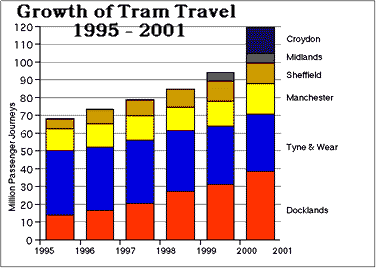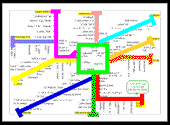|
TRANSPORT FOR THE
WESTERN RIVERSIDE
"FEWER CARS PLEASE...."
One of the key transport factors emerging from the Western Riverside
consultation process has been a strong determination that the
site should not be overrun with cars.
- From the public's point of view, car-based
development is seen as polluting, congesting and ugly.
- From the developers' point of view,
cars waste valuable land space which could be used more profitably.
- Even from the motorists' point of view,
there is a strong deterrent effect from the congestion surrounding
this site and the problems of parking when you get there.
Attempts to reduce car traffic elsewhere
in the city have shown that just banning the car is no solution.
Unless you provide a genuine alternative transport system, people
will simply drive themselves away.
"..BUT THEN WHAT? "
Of course there are some alternatives to the car for some people
and for some journeys, but for the majority of car users these
are not seen as real alternatives. If they really
were alternatives, the recent anti-car measures around Bath would
have resulted in a huge increase in bus and bicycle use, rather
than a drop in city-centre trade.
At present, about ten times as many
people travel into Bath by car as by any other mode; so a one-percent
decrease in car use should result in roughly a ten-percent
increase in other modes.
The latest figures show just a one-percent
increase in bus passengers after years of steady decline and
rising subsidy. Hardly a convincing argument for making the Western
Riverside a low-car-use zone.
THE ALTERNATIVE
Across the country, there has been only one significant switch
away from cars in recent years. Surprisingly, this has been the
result of the re-introduction of a transport mode which had been
almost forgotten in this country .

In Manchester, Sheffield, Wolverhampton and Croydon, the word "Tram" is once again on
everybody's lips. The rattling clanking trams of yesteryear have
become just a faded memory, displaced instead by the reality
of a sleek, quiet dependable and hassle-free way of getting around.
This is not just a 'bus replacement',
people in these cities are actually switching away from cars
in large numbers because they are finding the tram is better
than a car or a bus in a congested city centre. Plans for dozens
of tramway extensions are being pushed through, to cope with
the huge demand.
RAPID TRANSIT CORRIDOR PLAN
Since the days of Avon, there has been a background idea of some
sort of 'Rapid Transit' corridor in Bath. From time to time it gets dusted off,
assessed as unworkable - and put back on the shelf. No-one has
really looked into the underlying reasons why it would be unsuitable:
- It is a disruptive single corridor,
in isolation, with few stopping places.
- It does not interact with its surroundings
or the local travel needs of Bathonians
- It has been assessed as if it were
just another (rather specialised) bus route
This is still the underlying concept behind the B&NES plans for public
transport on the Western Riverside site - but the original reasons
why it was declared unworkable have not been dealt-with and it
is still unworkable.
WHAT DO WE REALLY NEED?
First and foremost, the Western Riverside needs a transport system
which people can use and will use. It has to be:
- A network which links the Western Riverside with the
rest of Bath and beyond
- A reliable system which you can take for granted and which
is there when
you want to catch it
- Integrated with its surroundings
- Suitable for
an historic city in the 21st century
- Well proven for regenerating brownfield sites and increasing prosperity
in Bath
- A real alternative to the car
for as many journeys as possible.
This is why Trams
for Bath has been advocating a modern
tramway network.
| The present plans will
link about 90% of the residential and employment areas of Bath
including the Hospitals and the University of Bath. They have
tramstops at all the existing and proposed Park+Ride sites, Bath
Spa Railway Station, the Bus Station, the Coach Station and all
around the city centre. |

Click for larger map |
Trams have the best record of any type
of public transport for reducing car traffic whilst simulaneously
regenerating brownfield sites by promoting trade and commerce.
Bath needs to 'get a quart into a pint pot' if business is to
continue to flourish and trams will allow better use of valuable
land resources.
WHAT THIS WOULD MEAN
The Western Riverside would be served by 3
routes simultaneously, resulting in
a 2-minute service at peak times with no more than one change
for access to anywhere in Bath.
The value of the site will be enhanced,
so developers can provide good quality development and employers
will want to locate their businesses there.
Electrical power ensures
that no fumes or noise will be generated anywhere on the site.
The trams can even go through buildings so that passengers do
not need to wait outdoors.
| A tram route should be at ground level
for ease of access and does not have
to follow a straight line. This allows greater flexibility
for planning and favourable location of the other types of routes.
It should, whenever possible, have its own right of way but must
not be isolated from the places people want to use it. The route to Newbridge should not be isolated
in an old railway cutting. |
 |
HOW WOULD BATH RAISE THE MONEY ?
Central
Government is looking very favourably
upon well-thought-out tramway proposals at the moment. It has
already pledged large amounts of money to new schemes across
the country. If Bath is to succeed in a major bid like this,
it will need to do a large amount of research first.
European money is available for research
into significantly new public transport schemes. Trams are not
new, but building a new tram network in a town the size of Bath,
with all its special architectural heritage, could be considered
particularly innovative. To apply for a European Grant will need
money too.
Some of the developers of the Western
Riverside site have stated very strongly that they are in favour
of a tram network and are prepared to back developments in this
direction. With their backing and the research which B&NES
already needs to do in order to keep the viability of the city
centre, an application for European money should be feasible.
LATEST MOVES
B&NES is now commissioning a "20-year Vision for Bath".
The Authority has at last shown a willingness to consider other
alternatives to the corridor concept. This is the opportunity
for B&NES to tear itself away from the muddled thinking of
the past and to come up with something which will be of long-term
benefit to the whole of the city and its surroundings.
TRAMS for BATH October 2001
|


